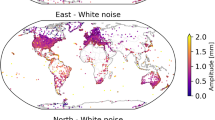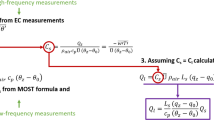Abstract
The atmospheric pressure fluctuations on Mars induce an elastic response in the ground that creates a ground tilt, detectable as a seismic signal on the InSight seismometer SEIS. The seismic pressure noise is modeled using Large Eddy Simulations (LES) of the wind and surface pressure at the InSight landing site and a Green’s function ground deformation approach that is subsequently validated via a detailed comparison with two other methods: a spectral approach, and an approach based on Sorrells’ theory (Sorrells, Geophys. J. Int. 26:71–82, 1971; Sorrells et al., Nat. Phys. Sci. 229:14–16, 1971). The horizontal accelerations as a result of the ground tilt due to the LES turbulence-induced pressure fluctuations are found to be typically \(\sim 2 \mbox{--} 40~\mbox{nm}/\mbox{s}^{2}\) in amplitude, whereas the direct horizontal acceleration is two orders of magnitude smaller and is thus negligible in comparison. The vertical accelerations are found to be \(\sim 0.1\mbox{--}6~\mbox{nm}/\mbox{s}^{2}\) in amplitude. These are expected to be worst-case estimates for the seismic noise as we use a half-space approximation; the presence at some (shallow) depth of a harder layer would significantly reduce quasi-static displacement and tilt effects.
We show that under calm conditions, a single-pressure measurement is representative of the large-scale pressure field (to a distance of several kilometers), particularly in the prevailing wind direction. However, during windy conditions, small-scale turbulence results in a reduced correlation between the pressure signals, and the single-pressure measurement becomes less representative of the pressure field. The correlation between the seismic signal and the pressure signal is found to be higher for the windiest period because the seismic pressure noise reflects the atmospheric structure close to the seismometer.
In the same way that we reduce the atmospheric seismic signal by making use of a pressure sensor that is part of the InSight Auxiliary Payload Sensor Suite, we also the use the synthetic noise data obtained from the LES pressure field to demonstrate a decorrelation strategy. We show that our decorrelation approach is efficient, resulting in a reduction by a factor of \(\sim 5\) in the observed horizontal tilt noise (in the wind direction) and the vertical noise. This technique can, therefore, be used to remove the pressure signal from the seismic data obtained on Mars during the InSight mission.




















Similar content being viewed by others
References
D.L. Anderson, W.F. Miller, G.V. Latham, Y. Nakamura, M.N. Toksoz, A.M. Dainty, F.K. Duennebier, A.R. Lazarewicz, R.L. Kovach, T.C.D. Knight, Seismology on Mars. J. Geophys. Res. 82, 4524–4546 (1977). doi:10.1029/JS082i028p04524
R. Beauduin, P. Lognonné, J.P. Montagner, S. Cacho, J.F. Karczewski, M. Morand, The effects of the atmospheric pressure changes on seismic signals or how to improve the quality of a station. Bull. Seismol. Soc. Am. 86(6), 1760–1769 (1996). http://bssa.geoscienceworld.org/content/86/6/1760
P. Delage, F. Karakostas, A. Dhemaied, M. Belmokhtar, P. Lognonné, M. Golombek, E. De Laure, K. Hurst, J.C. Dupla, S. Keddar, Y.J. Cui, B. Banerdt, An investigation of the mechanical properties of some Martian regolith simulants with respect to the surface properties at the InSight mission landing site. Space Sci. Rev. (2017). doi:10.1007/s11214-017-0339-7
D.P. Hinson, M. Pätzold, S. Tellmann, B. Häusler, G.L. Tyler, The depth of the convective boundary layer on Mars. Icarus 198, 57–66 (2008). doi:10.1016/j.icarus.2008.07.003
JPL and InSight Science Team, InSight environmental requirements document. JPL D-75253 (2013)
B. Kenda, P. Lognonné, A. Spiga, T. Kawamura, S. Kedar, W.B. Banerdt, R.D. Lorenz, D. Banfield, M. Golombek, Modeling of ground deformation and shallow surface waves generated by Martian Dust Devils and perspectives for near-surface structure inversion. Space Sci. Rev. (2017, submitted for publication)
M. Knapmeyer, J. Oberst, E. Hauber, M. Wählisch, C. Deuchler, R. Wagner, Working models for spatial distribution and level of Mars’ seismicity. J. Geophys. Res., Planets 111, 11006 (2006). doi:10.1029/2006JE002708
L.D. Landau, E.M. Lifshitz, Theory of Elasticity, 3rd edn., A Course of Theoretical Physics, vol. 7 (Pergamon, New York, 1970)
P. Lognonné, C.L. Johnson, Planet. Seismol. 10(4) (2007)
P. Lognonné, B. Mosser, Planetary seismology. Surv. Geophys. 14, 239–302 (1993). doi:10.1007/BF00690946
P. Lognonné, T. Pike, in Planetary Seismometry, ed. by V.C.H. Tong, R.A. Garcia (Cambridge Univ. Press, Cambridge, 2015)
P. Lognonné, J.G. Beyneix, W.B. Banerdt, S. Cacho, J.F. Karczewski, M. Morand, Intermarsnet ultra broad band seismology on intermarsnet. Planet. Space Sci. 44(11), 1237–1249 (1996). doi:10.1016/S0032-0633(96)00083-9
P. Lognonné, V.N. Zharkov, J.F. Karczewski, B. Romanowicz, M. Menvielle, G. Poupinet, B. Brient, C. Cavoit, A. Desautez, B. Dole, D. Franqueville, J. Gagnepain-Beyneix, H. Richard, P. Schibler, N. Striebig, The seismic OPTIMISM experiment. Planet. Space Sci. 46, 739–747 (1998). doi:10.1016/S0032-0633(98)00009-9
P. Lognonné, D. Giardini, B. Banerdt, J. Gagnepain-Beyneix, A. Mocquet, T. Spohn, J.F. Karczewski, P. Schibler, S. Cacho, W.T. Pike, C. Cavoit, A. Desautez, M. Favède, T. Gabsi, L. Simoulin, N. Striebig, M. Campillo, A. Deschamp, J. Hinderer, J.J. Lévéque, J.P. Montagner, L. Rivéra, W. Benz, D. Breuer, P. Defraigne, V. Dehant, A. Fujimura, H. Mizutani, J. Oberst, The NetLander very broad band seismometer. Planet. Space Sci. 48, 1289–1302 (2000). doi:10.1016/S0032-0633(00)00110-0
P. Lognonne, W.B. Banerdt, K. Hurst, D. Mimoun, R. Garcia, M. Lefeuvre, J. Gagnepain-Beyneix, M. Wieczorek, A. Mocquet, M. Panning, E. Beucler, S. Deraucourt, D. Giardini, L. Boschi, U. Christensen, W. Goetz, T. Pike, C. Johnson, R. Weber, K. Larmat, N. Kobayashi, J. Tromp, Insight and single-station broadband seismology: from signal and noise to interior structure determination, in Lunar and Planetary Science Conference. Lunar and Planetary Inst. Technical Report, vol. 43, 2012, p. 1983
R.D. Lorenz, Planetary seismology—expectations for lander and wind noise with application to Venus. Planet. Space Sci. 62, 86–96 (2012). doi:10.1016/j.pss.2011.12.010
R.D. Lorenz, S. Kedar, N. Murdoch, P. Lognonné, T. Kawamura, D. Mimoun, W. Bruce Banerdt, Seismometer detection of dust devil vortices by ground tilt. Bull. Seismol. Soc. Am. 105, 3015–3023 (2015). doi:10.1785/0120150133
I.T. Michaels, S.C.R. Rafkin, Large-eddy simulation of atmospheric convection on Mars. Q. J. R. Meteorol. Soc. 130, 1251–1274 (2004). doi:10.1256/qj.02.169
T. Mikumo, S. Watada, in Acoustic-Gravity Waves from Earthquake Sources, ed. by A. Le Pichon, E. Blanc, A. Hauchecorne (Springer, Dordrecht, 2009), pp. 263–279. ISBN 978-1-4020-9508-5
E. Millour, F. Forget, A. Spiga, T. Navarro, J.-B. Madeleine, L. Montabone, A. Pottier, F. Lefevre, F. Montmessin, J.-Y. Chaufray, M.A. Lopez-Valverde, F. Gonzalez-Galindo, S.R. Lewis, P.L. Read, J.-P. Huot, M.-C. Desjean, MCD/GCM development Team, The Mars climate database (MCD version 5.2), in European Planetary Science Congress 2015, vol. 10 (2015) p. 2438
D. Mimoun, P. Lognonné, W.B. Banerdt, K. Hurst, S. Deraucourt, J. Gagnepain-Beyneix, T. Pike, S. Calcutt, M. Bierwirth, R. Roll, P. Zweifel, D. Mance, O. Robert, T. Nébut, S. Tillier, P. Laudet, L. Kerjean, R. Perez, D. Giardini, U. Christenssen, R. Garcia, The InSight SEIS experiment, in Lunar and Planetary Science Conference. Lunar and Planetary Inst. Technical Report, vol. 43, 2012, p. 1493
D. Mimoun, N. Murdoch, P. Lognonné, T. Pike, K. Hurst, The SEIS Team, The seismic noise model of the InSight mission to Mars. Space Sci. Rev. (2017, submitted for publication)
N. Murdoch, D. Mimoun, R.F. Garcia, W. Rapin, T. Kawamura, P. Lognonné, Evaluating the wind-induced mechanical noise on the InSight seismometers. Space Sci. Rev. (2016). doi:10.1007/s11214-016-0311-y
Y. Nishikawa, A. Araya, K. Kurita, N. Kobayashi, T. Kawamura, Designing a torque-less wind shield for broadband observation of marsquakes. Planet. Space Sci. 104, 288–294 (2014). doi:10.1016/j.pss.2014.10.011
Y. Nishikawa, P. Lognonne, A. Spiga, K. Kurita, Evaluation of Mars’ background free oscillations with Martian general circulation model. Implications for detection of the InSIGHT mission. Space Sci. Rev. (2017, submitted for publication)
G.G. Sorrells, A preliminary investigation into the relationship between long-period seismic noise and local fluctuations in the atmospheric pressure field. Geophys. J. Int. 26, 71–82 (1971). doi:10.1111/j.1365-246X.1971.tb03383.x
G.G. Sorrells, J.A. McDonald, E.T. Herrin, Ground motions associated with acoustic waves. Nat. Phys. Sci. 229, 14–16 (1971). doi:10.1038/physci229014a0
A. Spiga, F. Forget, A new model to simulate the Martian mesoscale and microscale atmospheric circulation: validation and first results. J. Geophys. Res., Planets 114, 02009 (2009). doi:10.1029/2008JE003242
A. Spiga, F. Forget, S.R. Lewis, D.P. Hinson, Structure and dynamics of the convective boundary layer on Mars as inferred from large-eddy simulations and remote-sensing measurements. Q. J. R. Meteorol. Soc. 136, 414–428 (2010)
T. Van Hoolst, V. Dehant, F. Roosbeek, P. Lognonné, Tidally induced surface displacements, external potential variations, and gravity variations on Mars. Icarus 161, 281–296 (2003). doi:10.1016/S0019-1035(02)00045-3
W. Zurn, R. Widmer, On noise reduction in vertical seismic records below 2 mHz using local barometric pressure. Geophys. Res. Lett. 22(24), 3537–3540 (1995). doi:10.1029/95GL03369
Acknowledgements
This work has been supported by CNES and by ANR SEISMARS, including post-doctoral support provided to N. Murdoch and to T. Kawamura. B. Kenda acknowledges the support of the ED560 STEP’UP and of the NASA InSight project for his PhD support. This paper is InSight contribution 23.
Author information
Authors and Affiliations
Corresponding author
Rights and permissions
About this article
Cite this article
Murdoch, N., Kenda, B., Kawamura, T. et al. Estimations of the Seismic Pressure Noise on Mars Determined from Large Eddy Simulations and Demonstration of Pressure Decorrelation Techniques for the Insight Mission. Space Sci Rev 211, 457–483 (2017). https://doi.org/10.1007/s11214-017-0343-y
Received:
Accepted:
Published:
Issue Date:
DOI: https://doi.org/10.1007/s11214-017-0343-y




